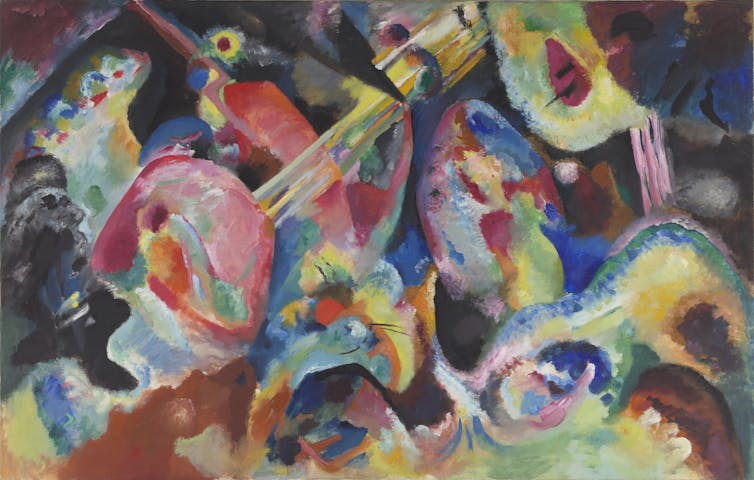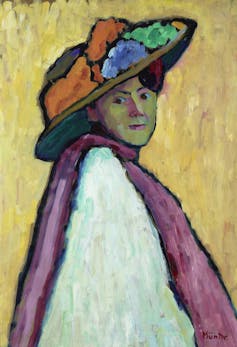Expressionism was an international art movement that flourished between 1905 and 1920. It was celebrated for bold colour experiments and dramatic forms. The expressionists were modern artists after post-impressionism (1886), cubism (1907-08), fauvism (1905) and futurism (1909). The influence, or confluence, of Picasso, Matisse and the futurists can be seen in various works in the Tate’s new show, Expressionists: Kandinsky, Münter and the Blue Rider.
The exhibition also reveals the movement’s entanglement with cross-cultural collaborations within the context of early 20th-century Europe’s imperial ideologies and social disparities. However, the narrative presented by the curators is steeped in modern-day attitudes, which are uncritically overlaid onto historical interpretations.
The Blue Rider was a group of artists who were active in Munich from 1911 to 1914. They are depicted in this exhibition as primarily focused on contemporary issues such as race, gender, environmentalism and ableism. This pervasive curatorial view obscures a nuanced understanding of the Blue Rider’s historical context and artistic motivations. Instead, it prompts viewers to uncritically engage with the curators’ interpretation.
The Blue Rider embodied an inherently internationalist outlook in a world of rising nationalism. The curators chooses to portray this in terms of colonial narratives. This is evident in the depiction of Kandinsky’s and Gabriele Münter’s trip to French colonial Tunisia.
Münter’s many photographs are accused of “orientalism” – the depiction of places and people in reductive, stereotypical and exoticised terms. Arguments, such as the British historian Robert Irwin’s suggestion, that orientalist art was motivated by a quest for knowledge and cultural exchange are not considered.
Münter’s photographs of women are also presented as partially redemptive, as they avoid typical orientalist depictions of women as sexually provocative. It is a pity that more time was not dedicated to exploring Münter’s use of photography beyond this postcolonial critique.
This strand of critique is extended to the exhibition’s interpretation of spirituality in the work. While expressionism is defined as the communication of subjective emotions and spiritual themes, Kandinsky aimed to convey a universal sense of spirituality through abstraction. However, the exhibition re-frames the group’s spiritually internationalist outlook. Expressionist spirituality incorporated European occult traditions with elements of Hinduism, Buddhism, Greek philosophy and modern science, as cultural appropriation.

The curators attempted to address the unequal gender divide in the group by foregrounding the contributions of the Blue Rider’s women artists and those exploring gender identities.
Room five, titled “Performing Gender”, serves as a focal point for this theme. The exhibition suggests that performance provided “safe spaces” for exploring sexuality and gender, framing the room around the Russian dancer Alexander Sacharoff’s and Russian artist Marianne Werefkin’s interest in performers who interchanged gender and power roles.
Such a framing is rooted in Werefkin’s declaration: “I am not a man, I am not a woman, I am I”, which the curators interprets as a rejection of gender binaries. However, it could equally signify a desire to be evaluated solely on one’s merits as a person and an artist, regardless of gender.
While the wall text asserts that “performance was central to both Werefkin and Sacharoff’s investigations and constructions of self-identity”, they did not explicitly “perform gender” in their art practice. Notably, the exhibition features no performances and “Performing Gender” only showcases paintings depicting theatrical scenes.
Another misstep in interpretation can be seen in the curation of Kandinsky’s abstract artwork which famously explored the concept of “synaesthesia”. This is the phenomenon where one sensory experience triggers another, such as hearing colours or seeing sounds. Here, the show reinterprets synaesthesia through the lens of neurodivergence.

They commissioned Public Art Works (a Turner Prize-nominated collective that collaborates with neurodiverse people) to make new artworks in response to the colour, form and expression explored in the work of the Blue Rider group. Tate’s attempt to bridge synaesthesia with contemporary understandings of neurodivergence was a missed opportunity for a thought-provoking exploration of how art can intersect with diverse neurological experiences.
Project Art Works’ “Blue Rider Residency 2024” is peripheral to the main exhibition and synaesthesia is not mentioned once on the residency webpage. Kandinsky operated within a different cultural and artistic context to Project Art Works. He neither engaged in collaborative work with neurodivergent people nor worked as a community artist. Instead, he harnessed the evocative interplay between colour and form to create aesthetic experiences that captivated the senses and emotions of his viewers.

Despite the prevailing need to view the work through a modern lens, the artworks on display manage to capture the essence of the era, offering glimpses into the spirit of the time. I was particularly drawn to some of Kandinsky’s early figurative works, which seemed to have a palette inspired by Maynards Wine Gums, and captivating portraits by female artists like Münter and Erma Bossie.
Münter’s Olga von Hartman and Portrait of Marianne Werefkin, with its not-so-subtle Matisse influence, were among the painterly highlights that left a lasting impression. Others, who want to see overlooked female members of the group or big names, such as Franz Marc, will find the entrance price worth it.
Expressionists: Kandinsky, Münter and the Blue Rider runs at Tate Modern until 20 October 2024.

